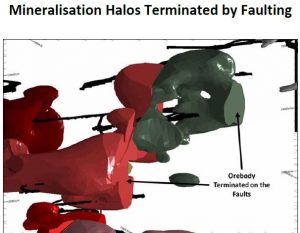Kombat Copper Project

 PROJECT DESCRIPTION
PROJECT DESCRIPTION
 The Kombat Copper Project is owned by Trigon Metals Inc. and is located some 37 km east of Otavi and 45 km due west of Grootfontein, Namibia in the Otavi Mountain Land on the Northern Platform Margin of the Damaran Orogenic Belt. The Kombat Copper Project is owned by TrigonMetalsInc.
The Kombat Copper Project is owned by Trigon Metals Inc. and is located some 37 km east of Otavi and 45 km due west of Grootfontein, Namibia in the Otavi Mountain Land on the Northern Platform Margin of the Damaran Orogenic Belt. The Kombat Copper Project is owned by TrigonMetalsInc.
The Kombat mineralised zones are carbonate-hosted base metal sulphide deposits associated with hypogene filled karst cavities and only occur along parallel “roll structures”, which are thrust-related folds. The orebodies occur below monoclinal flexures on the contact between the shales/phyllites of the Kombat Formation and dolostones of the Hüttenberg Formation. The ore zones exhibit an en échelon pattern relevant to each other and a crosscutting relationship with the contact. The ore lenses abut against this contact and hang like pendants beneath the flexures, are steep in dip and transgressive to the stratigraphy and may reach a few hundred metres in dimension. Orebodies vary in copper and lead content, along with silver.
MINXCON INVOLVEMENT
Minxcon conducted a 3D interpretation for all of the Kombat Project orebodies based on predominantly historical and some recent drilling data, historical development and sections. Orebody modelled dimensions were based on a 3Dgrade shell “mineralisation halo” wireframe model that was constructed in Leapfrog Geo™ software and cut off against the phyllite/dolostone contact and cross-cutting faults. The mineralisation halos were based on a natural mineralised cut-off of 0.3% (Cu+Pb) derived from the log probability plot and were used as the closed volumes within which the Mineral Resource block model was generated. Minxcon completed a Mineral Resource estimate for the Project for the generation of an NI 43-101-compliant Qualified Persons Report.
Minxcon conducted statistics, geostatistics and variography in order to generate a 3D kriged Mineral Resource estimate. Individual grade shells were estimated to ensure that no cross estimation occurred between grade shells. Only Inferred Mineral Resources were however declared due to the incomplete nature of the void data and the absence of QAQC on the historical drilling data. Search volume 1 (usually for Measured Mineral Resources) equated to 2/3 times the variogram range for each commodity, while search volume 2 (usually for Indicated Mineral Resources) equated to 1.5 times the variogram range. The third search volume was not calculated in order to assist with restriction of the estimate.
The result of the above exercise for the Mineral Resource estimate resulted in the first NI 43-101 Code compliant Mineral Resource estimate for the total Kombat Project.
This exercise once again illustrates the value of collating historical data and re-evaluating the data with modern technics and technology. The upside or value-add of this type of exercise is clear if the historical Mineral Resource statements are compared to the most recent Mineral Resource declaration. The historical Mineral Resources in the past were in the region of approximately 1.5 Mt (area and resource cut-off dependent) for selected portions of the mine to a now total Mineral Resource of approximately 6.91 Mt. This is a significant increase that clearly illustrates not only the potential of the project, but could improve shareholder value. Typically, new exploration targets are often discovered simultaneously.
The Mineral Resource was divided into an open pittable Mineral Resource and an underground Mineral Resource. The combined total Inferred Mineral Resources for the Kombat potential open pit and underground operations are presented in the table below.

- Historical mine voids have been depleted from the Mineral Resource.
- Historical mine voids were not available for Otavi thus the tonnage has been reduced by 1% for historical mining.
- Additional 7.5% porosity factor has been applied to Otavi for the karst voids.
- The open pit Mineral Resource is declared to a depth of 150 m with a CuEq cut off of 0.7 %.
- The underground Mineral Resource (below 150 m) is declared at a CuEq cut off of 1.4%.
- Densities for the hard rock material have been modelled.
- A geological loss of 15% has been applied to the Mineral Resource.
- All reported Mineral Resources are limited to fall within the property boundaries of the project area.
- Columns may not add up due to rounding.
- The Inferred Mineral Resources have a large degree of uncertainty as to their existence and whether they can be mined economically. It cannot be assumed that all or any part of the Inferred Mineral Resource will be upgraded to a higher confidence category.

